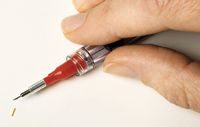Article
Insert aims to enhance intravitreal treatment safety
Author(s):
An international phase III study is well under way evaluating the efficacy and safety of an innovative intravitreal insert of fluocinolone acetonide (Medidur, Alimera Sciences and Psivida Inc.) for the treatment of diabetic macular edema (DME).

The investigational product represents a new generation in intraocular sustained-release technology that has been designed for ease of insertion and to provide long-term delivery of the corticosteroid at a very low dose.
The small insert measures 3.5 mm in length and 0.37 mm in diameter and contains a total fluocinolone dose of 180 µg. It is delivered into the posterior segment through the pars plana using a 25-gauge injector system during an in-office procedure. Following injection, the insert lodges in the vitreous base where it releases fluocinolone at initial rates of 0.5 µg/day or 0.2 µg/day, and it is expected to last for up to 18 or 36 months, respectively.

Favorable safety profile
"This controlled release device holds the promise of providing intravitreal corticosteroid treatment with a more favorable risk-to-benefit ratio relative to intravitreal injections of triamcinolone or the currently available intravitreal corticosteroid implants because it is minimizing drug exposure in terms of both the daily dose and total cumulative doses delivered," said Ken Green, PhD, senior vice president, scientific affairs, and chief scientific officer, Alimera Sciences, Alpharetta, GA.
"This delivery system was designed based on the premise that it might be possible to provide effective localized treatment but with a dose that is so low that its activity will be confined to the posterior segment for enhanced safety," he continued.
The matrix technology for the sustained-release fluocinolone intravitreal insert was developed by Controlled Delivery Systems (now Psivida Inc.) and was licensed by Alimera Sciences. The fluocinolone acetonide insert is being co-developed by the two companies.

That study is under way at centers in North America, Europe, and India. Eligible patients are those who have diabetes mellitus types 1 or 2, a best-corrected visual acuity of 19 to 68 letters, and a retinal thickness exceeding 250 µm measured by optical coherence tomography; also, the investigator must deem them suitable to have macular laser treatment deferred for 6 weeks. These patients are being randomly assigned to one of three arms to receive an insert releasing fluocinolone acetonide 0.2 µg/day or 0.5 µg/day or a sham injection. Based on follow-up of their disease status, all patients are eligible to undergo treatment with laser photocoagulation after 6 weeks.
The study plans to enroll 900 patients who will be followed for 3 years. As of the end of January, about 40% of that target had been entered, and patient recruitment is expected to be completed in the third quarter of this year.
Newsletter
Don’t miss out—get Ophthalmology Times updates on the latest clinical advancements and expert interviews, straight to your inbox.




